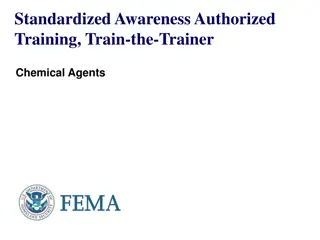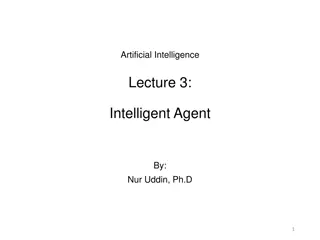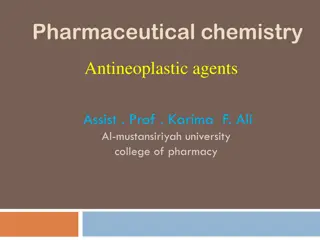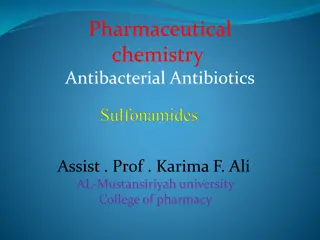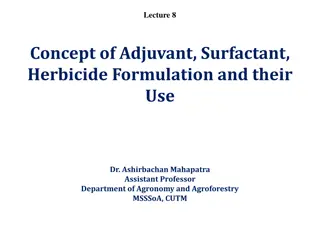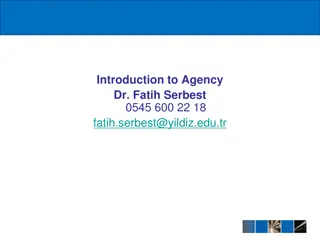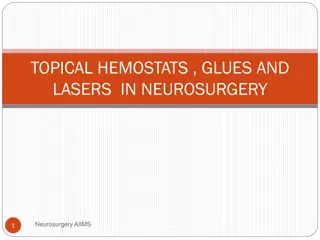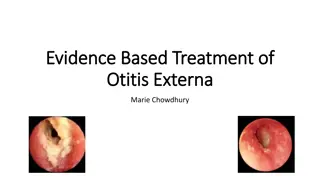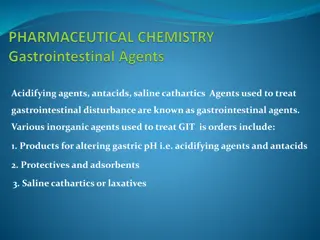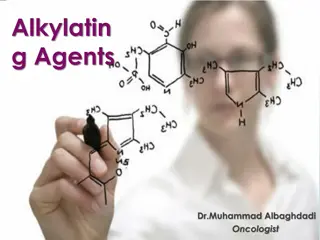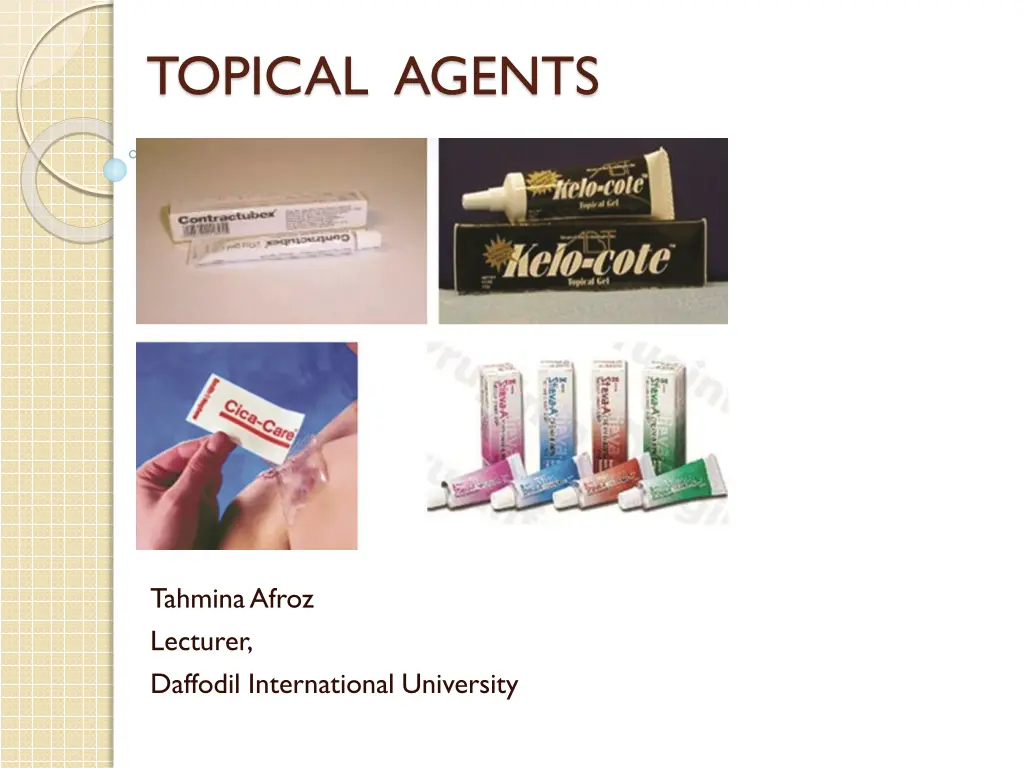
Understanding Topical Agents and Their Protective Properties
Explore the world of topical agents used on skin and mucous membranes, uncovering their protective actions to prevent inflammation and promote healing. Learn about various formulations, applications, and the ideal properties of protective agents. Discover the benefits of using protective substances like talc and their applications in pharmaceutical preparations, both cosmetic and medicated.
Uploaded on | 0 Views
Download Presentation

Please find below an Image/Link to download the presentation.
The content on the website is provided AS IS for your information and personal use only. It may not be sold, licensed, or shared on other websites without obtaining consent from the author. If you encounter any issues during the download, it is possible that the publisher has removed the file from their server.
You are allowed to download the files provided on this website for personal or commercial use, subject to the condition that they are used lawfully. All files are the property of their respective owners.
The content on the website is provided AS IS for your information and personal use only. It may not be sold, licensed, or shared on other websites without obtaining consent from the author.
E N D
Presentation Transcript
TOPICAL AGENTS TahminaAfroz Lecturer, Daffodil International University
Topical Agents Topical agents:Agents which are applied on skin or mucus membrane and body cavities that open to the out side and give their local effects. Sites of applications:Skin ,eye ,ear,nose ,vagina,rectum Types of formulations: powder , ointment , creams , lotion , spray, transdermal patches etc. The compounds used topically will be divided into broad categories based on their usual action or use. The categories are: (1) Protective and (2)Antimicrobial and astringent compounds.
Protectives Protective are the agents that exerts their action by covering the skin or mucus membrane and prevents inflammation at the site of application. They forms a coat or a film on the site of application (like wound , burned skin) and prevent contact of harmful causes(like bacteria , moisture ,dust ). Ideal properties: Agents are insoluble in water, Chemically as well as biologically inert. Adsorbent action.
PROTECIVES Insolubility is a desirable property in that this limits the absorption of the compounds through the skin, makes it difficult to wash them off . Compounds which are chemically unreactive are necessary in order to prevent interactions between the protective substance and the tissue.In other words - Ideal protective are biologically inactive. Adsorbent action is an important property of protective.Protective and adsorbent action is maximized with decreasing particle size. Small particles offer a larger surface area, allowing them to adhere to each other, adhere better to the surface of the skin, and adsorb moisture more efficiently
APPLICATION Protective are generally applied as dusting Powders, suspensions containing the insoluble protective substance or ointments. It should be remembered that protective and adsorbent substance are available for use internally for gastrointestinal irritations. (Although the reason for using these is the same, the compound and preparation are not.) Topical protective and adsorbents are usually applied to areas of the skin which are subject to constant irritation due to moisture and/or friction , or areas which have already become irritated or inflamed due to friction,allergy and the like.
PROTECTIVE PRODUCTS Talc (MgO.4SiO2.H2O): Talc U.S.P. is hydrous magnesium silicate, sometimes containing a small proportion of aluminum silicate. The U.S.P. describes it as a very fine, white or grayish white, crystalline powder. It is unctuous, adheres readily to the skin and is free from grittiness. Talc is odorless, tasteless and insoluble in water, dilute acids and dilute bases. Talc is used in preparations which may be perfumed for cosmetic purposes,or medicated with antimicrobial agents,such as boric acid. Some of the pharmaceutical preparations employ talc as a filtering or distributing agent are aromatic waters, Magnesium Citrate Solution, aromatic elixir and Orange syrup.
PROTECTIVE PRODUCTS Zinc Oxide(ZnO;Mol.Wt.81.37) Zinc Oxide U.S.P. is a very fine, odorless, amorphous, white or yellowish white powder, free from gritty particles. Zinc Oxide is insoluble in water and alcohol , and will gradually absorb CO2 from air to form a basic Zinc carbonate [Zn2 (OH)2CO3 ] Use: It is used as an astringent & topical protective. The antimicrobial-astringent action is due to the release of a small amount of Zinc ion from hydrolysis in the acidic moisture on the skin. It is used as a protective in ointment, pastes and dusting powders in the treatment of skin ulcerations and other dermatological problems. As a dusting powder, it is frequently found in combination with other protective or antimicrobial agents e.g.Talc and BoricAcid. Zinc Oxide is the primary ingredient in Calamine. Zinc gelatin is a protective jelly containing 10% ZnO.
PROTECTIVE PRODUCTS Calamine(ZnO.xFe2O2) Calamine is zinc oxide with a small proportion of ferric oxide. The material is a fine power, odorless, and practically tasteless. It is insoluble in water but almost completely soluble in mineral acids. Use: It is used as a topical protective. It is used in dusting powders, ointments, and lotions where it is applied to the skin for its soothing,adsorbent,protective properties. Calamine lotion is one of the most widely used preparations containing calamine. The lotion is a protective with a good drying effect and a mild astringent action.
PROTECTIVE PRODUCTS Zinc Stearate:([CH3(CH2)CO2]2Zn) Zinc stearate as a compound of zinc with a mixture of solid organic acid obtained from fats.Zinc stearate is insoluble in water,alcohol and ether. Use: It has mild astringent and antimicrobial properties. It is used in dusting powders and ointments as a protective. It is widely used as a lubricant in the manufacture of tablets. The inhalation of zinc stearate dust can cause pulmonary inflammation. For this reason, its routine use as a dusting powder for infants and children should be strongly discouraged.
PROTECTIVE PRODUCTS Titanium Dioxide (TiO2;Mol.Wt.79.90) Titanium Dioxide is a white amorphous, odorless, tasteless, infusible powder. It is insoluble in water,hydrochloric acid,nitric acid,and dilute sulfuric acid. Use: It is used as a topical protective. It is useful for screening out ultraviolet radiation. It is also used as a white pigment in cosmetics and paints.
Antimicrobials & Astringents Antimicrobial terminology: Antiseptic: This term is generally applied to any agent which either kills or inhibits the growth of microorganisms, i.e. bacteria, fungi, protozoans,etc. Germicide: The term germicide refers to a more specific action in that it describes agents which kills microorganisms, e.g. bactericide (agents which kill bacteria), fungicide (agents which kills fungi), amebicide, etc. Disinfectant: This term refers to the use of activity as the term germicide, above. Its usage differs in that it is applied to those agents most appropriately used on inanimate objects, e.g., instruments, equipment,rooms,etc.
Antimicrobials & Astringents Antimicrobial terminology: Sterilization: This refers to the use of a disinfectant or other procedure to render an object completely free of microorganisms. This frequently involves the use of chemicals or mechanical processes (e.g. Heat) which are much too stringent for use on animal or human tissue. Antiseptic and germicide may be further subdivided according to their area and type of use. For example, agents may be classified with respect to whether they are used topically or internally. Internal agents may be further subdivided into those are absorbed (systemic) and those that are not absorbed (non-systemic). The former compounds are distributed through the circulation and used to treat infections in various organs and tissues, while the latter agents remain and function in the area where they are applied, e.g., the gastrointestinal tract.
Antimicrobials & Astringents Mechanism of Action: The mechanism of action of inorganic antimicrobial agents can be divided into three general categories: 1. Oxidation 2. Halogenation 3. Protein precipitation These represent the primary chemical interactions or reactions that occur between the agent and microbial protein and result in the death of the microbe or inhibition of its growth. 1.Oxidation: These compounds capable of functioning as antimicrobial agents through oxidative mechanisms are generally nonmetals and certain types of anions. Most common among these are hydrogen peroxide, metal peroxides, permanganates, halogens (i.e. Chloride and Iodine), and certain Oxo-halogen anions. The effective oxidative action of these compounds involves the reducing groups present in most proteins, e.g. the sulfhydryl (-SH) group in cysteine.
Antimicrobials & Astringents Figure: An illustration of the action of oxidizing agents on protein containing sulfhydryl groups. A) The protein before oxidation showing the presence of free sulfhydryl group B) the protein after oxidation showing the formation of a disulfide bridge between two-SH groups. The protein has a specific function in the microorganism. The formation of the disulfide bridge will alter the conformation (Shape) of the protein and thereby alter its function. The overall change or destruction of function in specific protein is responsible for the ultimate destruction of the microorganism.
Antimicrobials & Astringents Mechanism of Action: 2. Halogenation: This is a reaction occurring with antiseptics of the hypohalite type and in particular, hypochlorite, OCI-. These types of compounds cause chlorination with the peptide linkage of the protein molecule. An example of this is shown below:: This reaction is ultimately destructive to the function of specific proteins because the substitution of the chlorine atom for the hydrogen produces changes in the forces (hydrogen bonding) responsible for the proper conformation of protein molecule. Hypohalite: Ahypohalite is an oxyanion containing a halogen in oxidation state +1. peptide linkage:(The chemical bond formed between amino acids, constituting the primary linkage in all protein structures. In a peptide bond, the carboxyl group (COOH) of one amino acid bonds with the amino group (NH2) of another, forming the sequence CONH and releasing water.)
Antimicrobials & Astringents Mechanism of Action: Protein Precipitation: The type of mechanism involves the interaction of proteins with metallic ions .The nature of the interaction is one of complexation in which the various polar groups on the protein act as ligands. The complexation of the metal results in a radical change in the properties of the protein or protein precipitant. Figure: A model illustrating the interaction between a metal ion and a protein, resulting in protein precipitation. Ligands: an ion or molecule attached to a metal atom by coordinate bonding.
Astringents The application of a very dilute solution of a metal cation to tissue primarily provides a local or surface protein precipitant action. This activity is usually designated as being astringent. Being a surface phenomenon, it does not usually result in the destruction of host tissue. Its effect can be observed or felt, however, when applied to skin or mucous membranes. This effect can be generally described as a Shrinkage or firming of the tissue. For example, astringents will cause the constriction of capillaries and small blood vessels, hence, they are used as styptic to stop bleeding from small cuts. The astringents are also used to reduce the volume of exudate from wounds and skin eruptions. They are also found as anti-perspirants in deodorants because of their ability to constrict pores and destroy microorganisms that may produce body odors.
Antimicrobial Astringent Agents Hydrogen peroxide solution (H2O2): Hydrogen peroxide solution U.S.P. contains, in each 100ml, not less than 2.5 g and not more than 3.5 g of H2O2. Suitable preservatives totaling not more than 0.05% may be added. It is a clear, colorless liquid which may be odorless or may have an odor resembling that of ozone. It is unstable on prolonged exposure to light, and may decompose suddenly when rapidly heated. Pure Hydrogen Peroxide, at room temperature is a colorless, syrupy liquid with astringent properties. Use: It is used undiluted for its mild antiseptic and cleansing effects on wounds. It is used as a gargle or mouthwash in the treatment of bacterial infections of the throat and mouth by dilution with one part of water.
Antimicrobial Astringent Agents Sodium Hypochlorite solution (Dakin s Solution): It contains not less than 4.0% and not more than 6.0% by weight of NaOCl. It is a clear, pale greenish yellow liquid having an odor of chlorine. The solution is affected by light. Use: It is useful as a disinfectant and laundry bleach. It is an effective germicidal agent that can be used to disinfect areas, instruments and utensils which have been exposed to pathogenic organisms.
Antimicrobial Astringent Agents Diluted Sodium Hypochlorite solution (Modified Dakin s Solution): It is described as a solution of chlorine compounds of sodium containing in each 100ml, not less than 450.0 mg and not more than 500.0 mg (or approximately 0.5%) of NaOCl. The solution is a colorless or light yellow liquid having a slight odor suggesting chlorine. Use: It has been used in the past as an antiseptic on pus-forming (suppurating) wounds, and as an irrigation solution for infections inside certain body openings. While the solution is very effective both as an antiseptic and at removing necrotic tissue it has the disadvantages of dissolving certain type of joints, and of dissolving blood clots and prolonging clotting time. These properties can lead to secondary hemorrhage, and other antiseptics should be chosen when these are potential problems.

